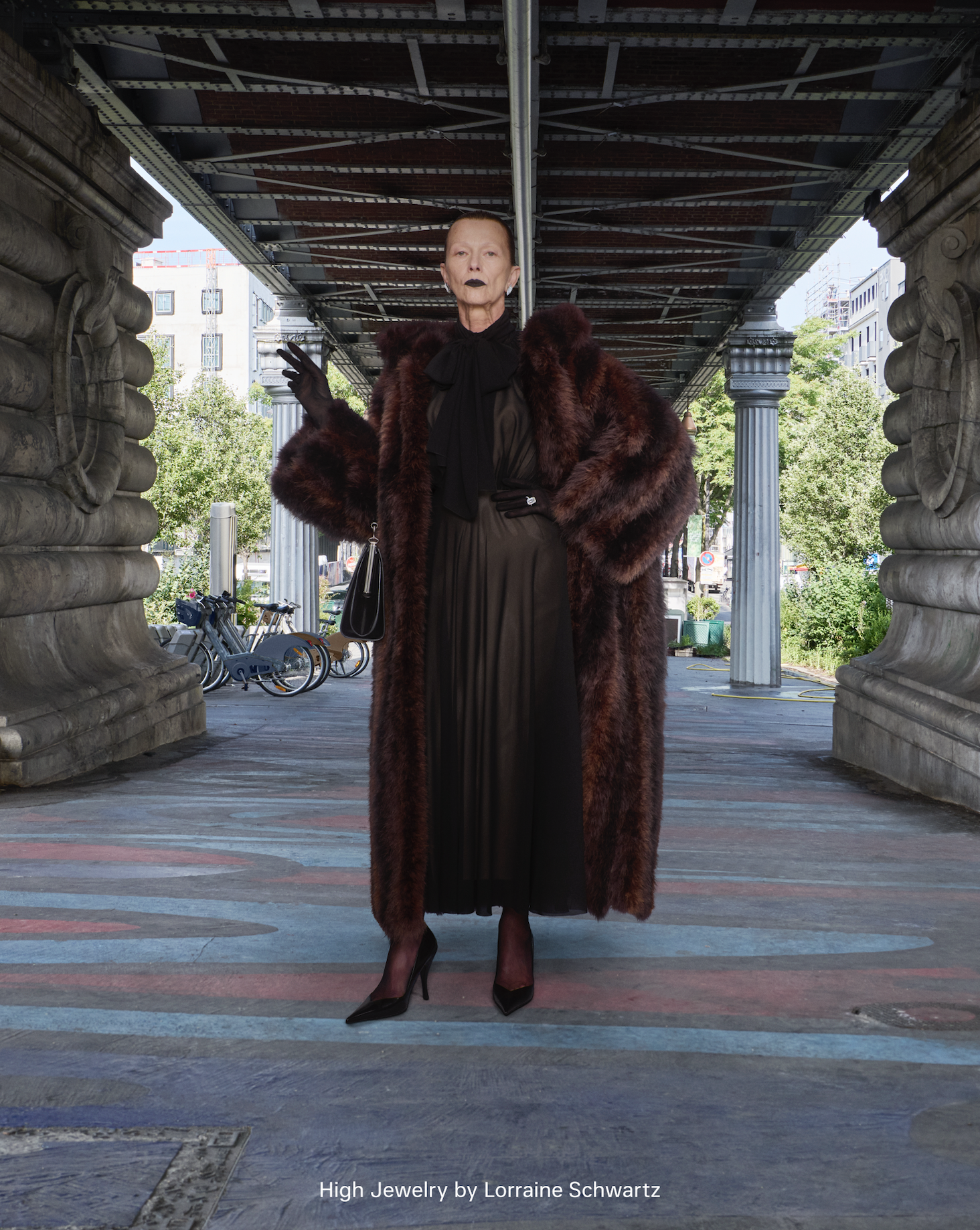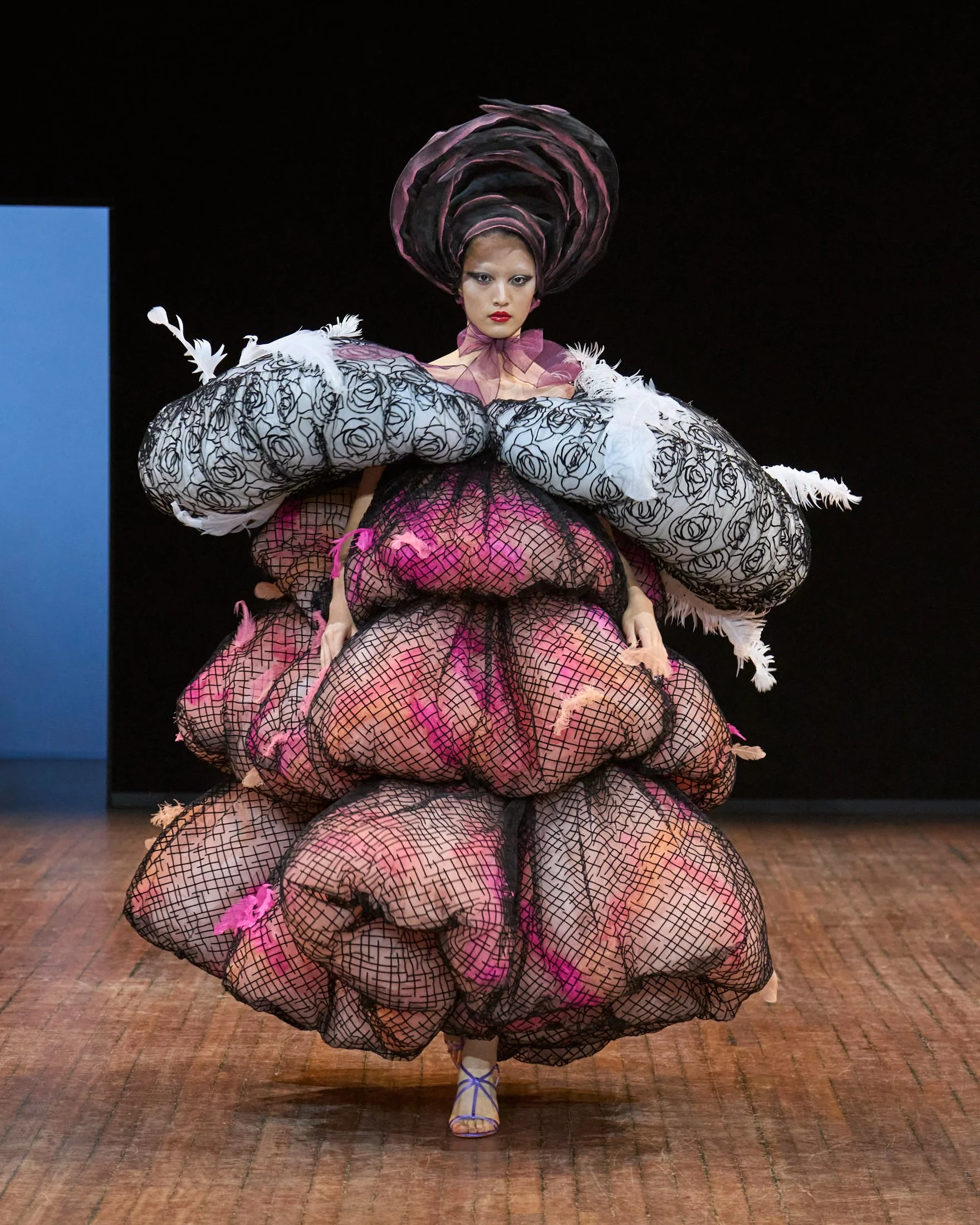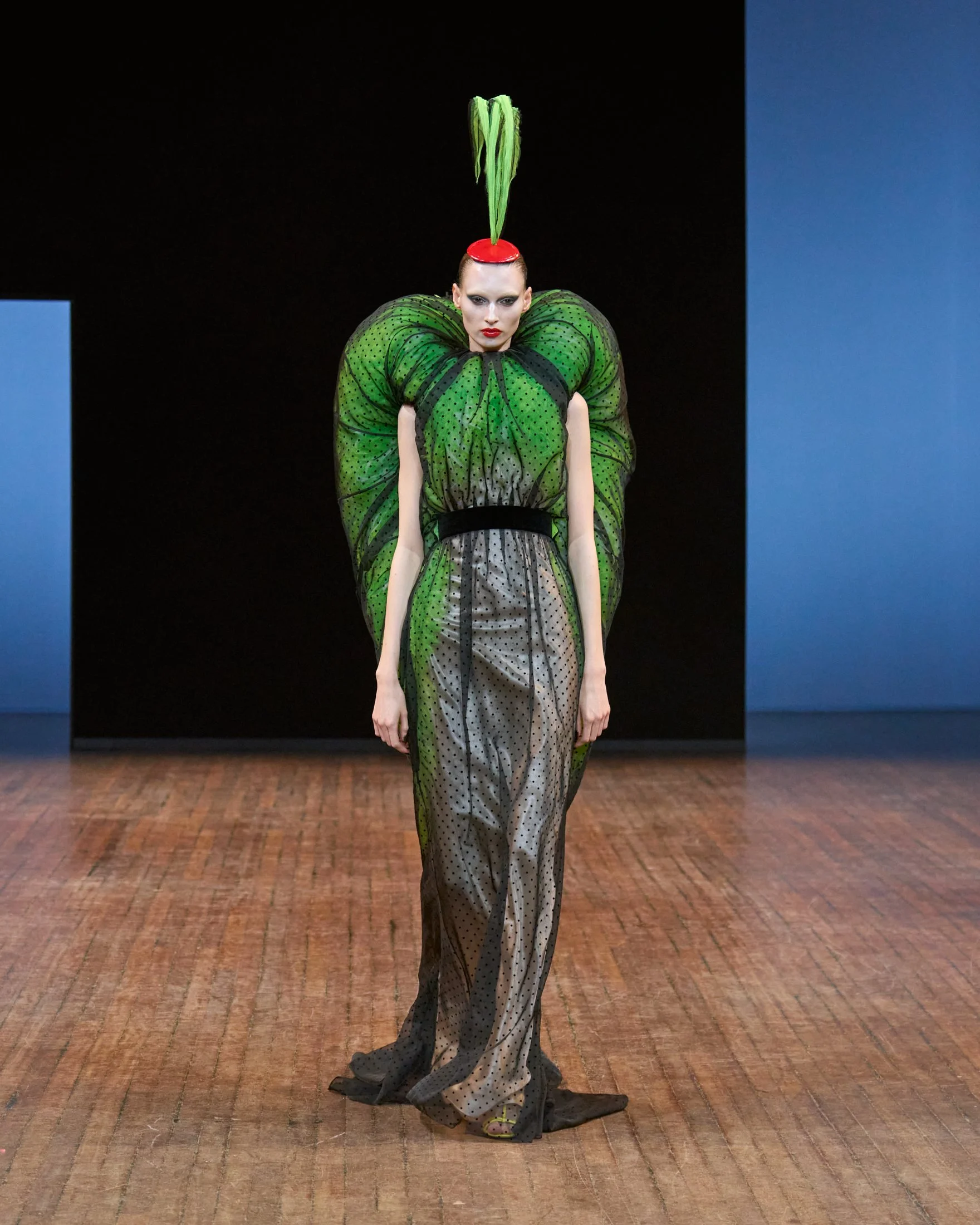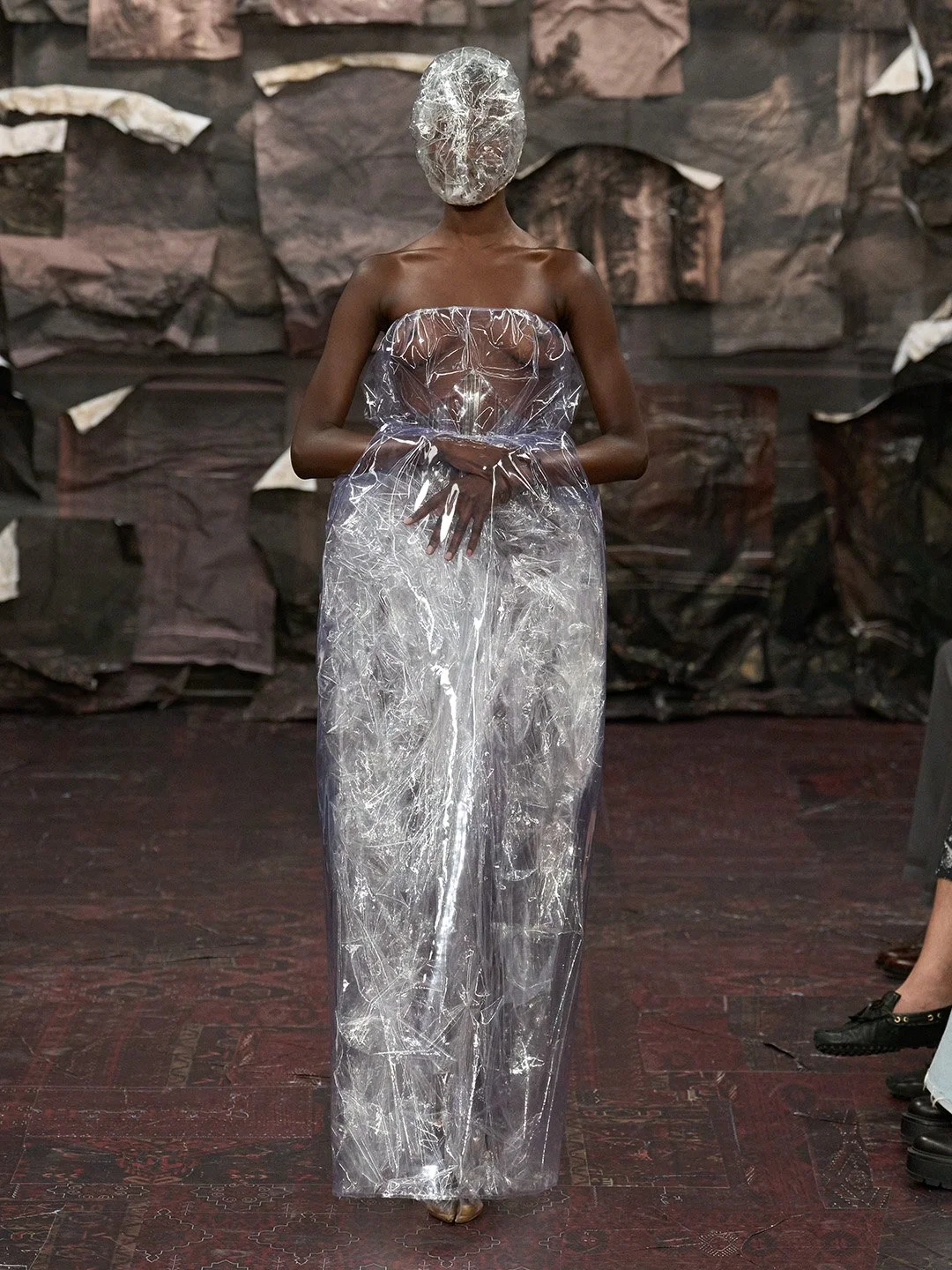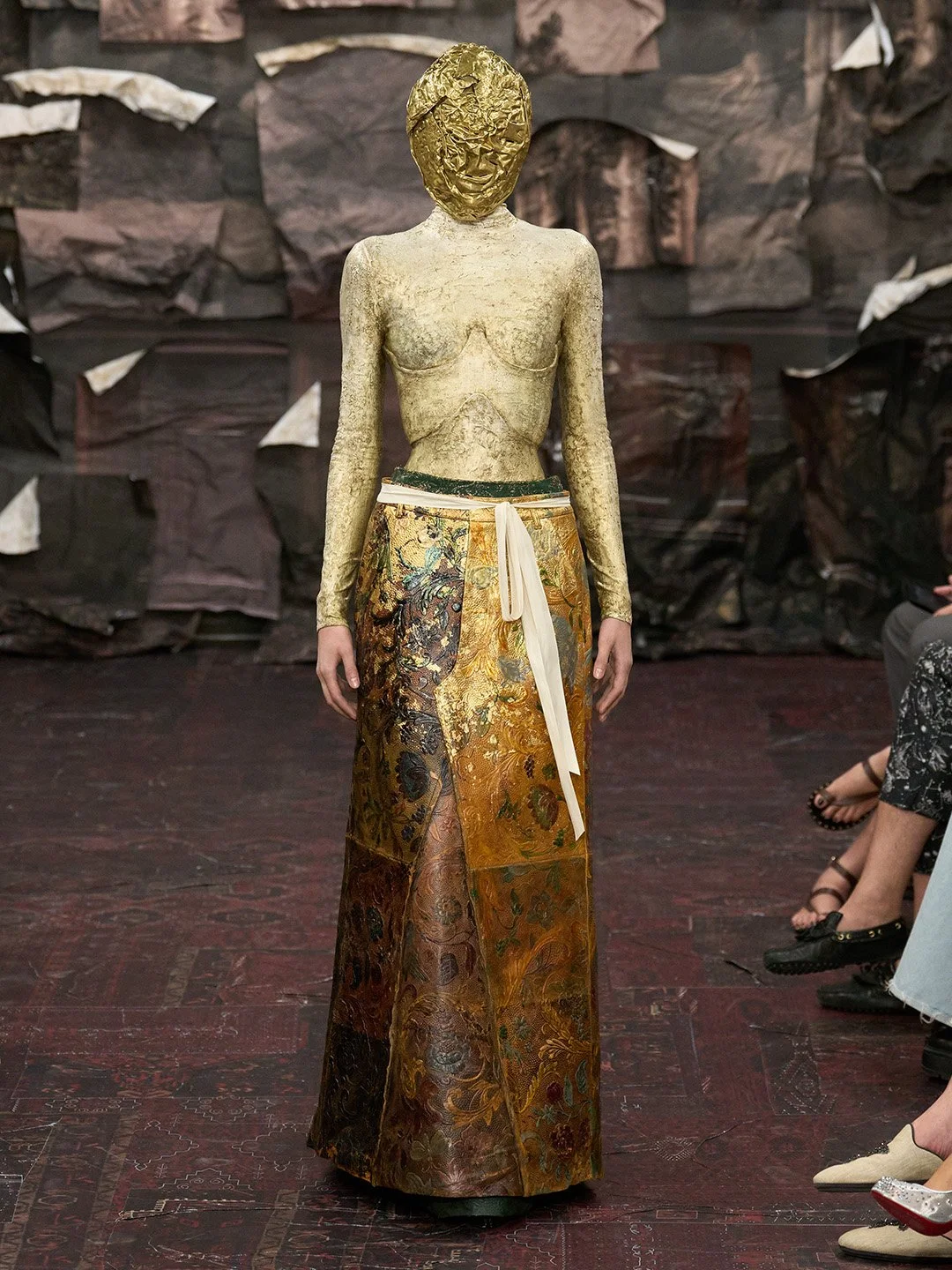HAUTE COUTURE WEEK FALL/WINTER 2025: DAY 3
editors ELIANA CASA, MAREK BARTEK and MARIE-PAULINE CESARI
ROBERT WUN
review by MAREK BARTEK
all images ROBERT WUN provided by the brand
Robert Wun’s ‘Becoming’ wasn’t about dressing up. It was about what dressing means: how we prepare, how we project, how we transform. The show unfolded like a storyboard of internal moments, staged not for reality but for reflection. In place of linear narrative, a slow procession of highly sculpted silhouettes asked a quieter question: what does it feel like to become something else?
No softness here, no looseness. Wun thrives on exactitude. Every look was meticulously engineered, from the enormous padded cape embroidered with ghostly, forensic sequinned handprints to the sharply tailored gowns that shifted shape with each step. Architectural rigour met cinematic drama. At times the garments resembled relics, too precise to be purely decorative, too emotional to be just form.
Construction served narrative. Tuxedoed handbags reinforced the idea that everything can—and should—be dressed. Mannequin arms clutched the body like memories, or projections, or warnings. Wun kept it charged. The emotion was in the control. The bridal look was the clearest expression of the collection’s thesis. A light beige gown crowned with a miniature human figure clutching the veil. Not just a display of craft, but a statement: becoming isn’t always liberating. Sometimes it’s a burden, a gaze you carry. The surrealism didn’t serve shock value but rather it asked you to sit with the discomfort, and read the garment as psyche.
There was no overt nostalgia, no literal references. Still, the collection hinted at the private rituals of preparation. Fragrance before departure, the act of seeing oneself reflected. Couture not as a show, but as internal monologue rendered three-dimensional. Emotion encoded into pleats, into pressure points, into weight.
Wun doesn’t chase relevance. His world exists parallel to fashion’s seasonal rhythms. ‘Becoming’ was immersive, sculptural, unapologetically cerebral. A rare example of a designer willing to follow an idea all the way through, and then cut it in satin.
BALENCIAGA
review by NIA TOPALOVA
all images BALENCIAGA provided by the brand
Demna got us all tearing in awe with his very last, 54th Couture collection for Balenciaga, as he brought Cristóbal’s legacy to life, while also keeping the shapes, gestures and approach to the body that has defined Gvasilia’s work. With this collection, he reaffirmed how much couture matters to him.
In tribute to everyone’s dedication to the House, the show began in silence, accompanied only by the voices of each person who has been involved with the vision of Balenciaga over the last decade, stating their names. Demna’s name was kept for the very end, followed by “No Ordinary Love” by Sade, which closed the show.
More than once has Demna talked on the importance of couture, on the way it liberates him, slows him down just enough to distance himself and open more space for stillness and quietness in his mental process. Always translating clothing into a subject of social or political commentary, to then transform these comments into beauty, into garments that carry a statement but are also emotionally (and aesthetically) charged.
This time, the setting of the show was very intimate, as the first model walked in a sculptural all white silhouette. A starting point of the collection was a study of the “La Bourgeoisie” dress codes, and the Medici and Nosferatu-esque constructions. Throughout the collection, the references to Cristóbal Balenciaga were present consciously and subconsciously. Demna once called Cristóbal “a surgeon of clothes”, one who cuts into the fabric to open it, to then change the whole posture. From the very beginning, Demna could connect to his way of work and thought process like no one else.
The Golden Age of Hollywood was reinterpreted with the “Diva” gown referencing Marilyn Monroe, and a special ode to Elizabeth Taylor — a mink coat made of embroidered feathers was complimented by Taylor’s personal diamond pendant earrings. Nine “one-size-fits-all” made-to-measure on a bodybuilder suits were worn by models with different body types, stating that it is not the garment that defines the body, but quite the opposite – another proof that Demna does not simply design a suit, he searches for what the suit represents in a contemporary social commentary.
Once again Demna honoured his team by replacing the handbag’s logos with the names of the models wearing them, setting the tone for a show rooted in humility and authenticity. The finale sculptural lace gown shaped by millinery techniques was a true representation of “everything this House stands for”.
Balenciaga by Demna Gvasalia really was “no ordinary love”, and this final collection reflected his purity and the immense importance of his body of work.
“I have come as close as possible to being satisfied in this endless pursuit of impossible perfection – the defining ethos of Cristóbal Balenciaga.”
VIKTOR & ROLF
review by MAREK BARTEK
all images VIKTOR & ROLF provided by the brand
At Viktor&Rolf, fashion has always been a study in contradiction, where theatricality meets realism, and absurdity becomes precision. For Autumn/Winter 2025, the Dutch duo take this ethos to new heights with ‘Angry Birds’, a couture collection composed entirely of mirrored pairs. Thirty looks of fifteen designs shown twice perform a clever, couture crafted illusion: one version is puffed up with colourful feathers, while its twin is stripped back and bare, a shadow in silk, if you will.
The structure of the collection is both literal and conceptual: each silhouette is technically identical, but the presence, or absence, of feathers radically shifts its identity. In one, a coat morphs into full feathered glory; in the other, it collapses back into minimal, wearable form. What is usually ornamental becomes foundational. Feathers form the shape, set the tone, and shift the mood. That being said, not a single plume is real. Over 11,500 hand-crafted feathers, made from organza, tulle, and other fabrics, have been stitched, sculpted, and dyed to mimic nature through illusion. Trompe-l’œil artistry turns lightness into volume and colour into structure. The result: garments that breathe, swell, and then deflate, literal studies in volume and void.
Looks ranged from ballooning cloqué coats framed by tubular outlines filled with caramel-hued feathers, to sheer polka dot gowns that crack open to release bursts of neon green and parrot-coloured plumage. There were velvet ribbon bows, lurex fringe trenches, padded hip volumes, sculpted bonnets and velvet headbands, all crowned with extravagant feathered millinery by Stephen Jones. Christian Louboutin’s custom satin stilettos grounded each look, a consistent signature in a collection built on transformation.
While some silhouettes recalled Viktor&Rolf’s archival couture debut from Fall 1998 — when looks were also doubled and volumes echoed — this season feels sharper, more ironic, and more introspective. The flamboyant is not just playful, it’s poised on the edge of eruption. Every loud silhouette has a shadow, and the collection holds space for both: drama and discipline, costume and clothing, performance and personhood.
And what of the name, 'Angry Birds’? The reference may seem shallow, but as with Viktor&Rolf’s perennial perfume ‘Flowerbomb’, there’s pleasure in dissonance. It’s the clash of aggression and innocence, the unexpected friction of ideas that sparks the couture to life.
MAISON MARGIELA
review by MAREK BARTEK
all images MAISON MARGIELA provided by the brand
Glenn Martens unveiled his debut for Maison Margiela’s Artisanal line — the house’s take on haute couture, but in true Margiela spirit, “couture” filtered through broken mirrors, battered leather, plastic drapery and the scent of Flemish wallpaper. And of course, this wasn’t just any debut. It was thee debut. There is a lot of legacy to carry but Glenn didn’t flinch. Instead, he reached into the archives—both literal and emotional—and pulled out something uncanny, cracked, otherworldly, and ultimately beautiful.
Guests were summoned to the 19th arrondissement, to Le Centquatre, the same space where in 2009 we witnessed Martin’s last show. An old municipal morgue (very on brand), got a makeover. Walls covered in photocopied, peeling paper, mismatched wooden chairs, and all lit by fluorescent lights. Disorienting but in the best way, it felt like stepping into a post-apocalyptic mansion where time collapsed, and the clothes were the only thing that remained.
The show opened to the sound of Spanish guitar, soft and eerie. Models walked out shrouded, masked, and unsettlingly slow. Each face hidden behind some version of a veil made out of organza and lace, encrusted with shattered jewels, or literal hammered metal masks shaped from salvaged objects. As Martens said backstage, it was a nod to “anonymity, sure—but also mystique.” The first looks were translucent. Dresses sculpted from scrunched-up plastic, shower curtains or vacuum-sealed bags but make it couture. Martens mentioned blown glass as inspiration, and you could feel it: glossy, fragile, and strange. Pockets were sewn into the folds, giving the models something to do with their hands, which made the silhouettes even more ghostlike. But the drama came in the form of golden molten gowns that looked like melted metal. Crushed velvet dresses shimmering like oxidised copper. Wallpaper-printed jackets, coats and skirts were pieced together from upcycled leather jackets, and draped jersey dresses swaddling bodies in smoky greys and dusty beiges, were cinched with sculptural corsets that flared at the hips and jutted at the ribs—part Galliano, part cathedral artefact.
There were clear nods to Margiela’s early codes of upcycling, masks, anonymity, but also to Glenn’s own greatest hits. If you squinted, you could see his Gaultier couture cameo in the golden sapphire dress. Or his Diesel-era sculptural denim sensibility in the feathered skirts cut from shredded jeans. Even the infamous “janties” (jeans + panties) somehow made spiritual sense in this new, antique, alien universe. What Martens did best was balance extremes: extravagance and rot, control and chaos, the sacred and the absurd. A dress would look saintly from one angle, then tilt and reveal an almost alien silhouette. The materials were sometimes so heavy (especially the heavily beaded masks) that models swayed visibly under the weight, their movements slowed, almost ceremonial.
But beneath all the theatrics was a quiet dedication to craftsmanship. Martens shared that a third of the collection was made from found or recycled materials. Thrifted clothes from Paris’ Guérissol stores, transformed into new couture. Costumes became corsets, wallpaper became fabric, and junk jewellery turned into crown-like headpieces. There were also softer, more delicate chapters, in the form of feathered appliqués on sheer dresses, translucent tulle cutouts or lace peeling like old frescoes. In one standout look, the model appeared entirely veiled, like a ghost nun sculpted from chiffon and silence. The closing look was a story on its own. A chartreuse gown crowned with a garden-like ruffled mask, like a Flemish still life come to life. Lush, decaying, and unsettlingly beautiful.
With a cultural weight this show carried, it comes as no surprise that not everyone was enchanted. Some critics thought the pacing dragged, that the repetition of masks dulled the impact. Fair enough. But maybe that was the point? This wasn’t fashion as red carpet fodder. It was fashion as reminder, fashion as emotion, fashion as storytelling.
As Martens said backstage, “I’m from Bruges, it’s a gloomy, Gothic place. That darkness is part of me.” With this debut, he went way and above just honouring the past of the brand. He reshaped it, filtered it through his own Belgian soul, and handed us something that felt at once ancient and entirely new. If this is what Glenn Martens does in chapter one, then Margiela is in thrillingly strange hands.




